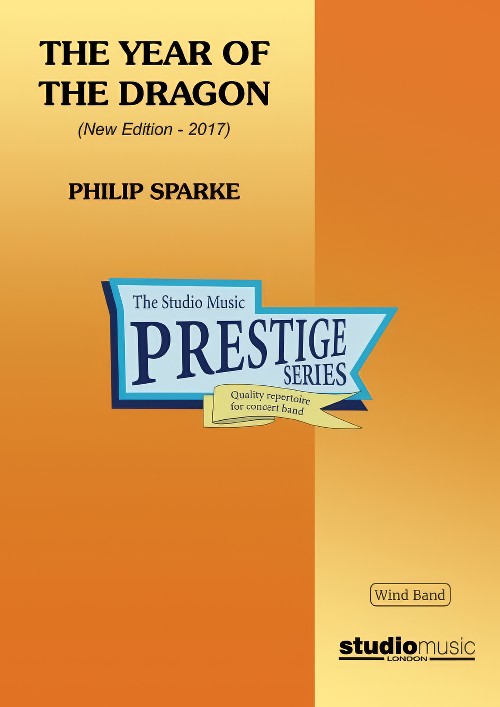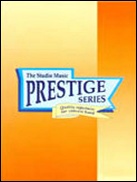Results
-
 £48.66
£48.66Illuminate - Wind Band (Andrew Wainwright)
Premiered at London's O2 Arena to an audience of 20,000 people, Illuminate has become a highly popular item on concert programmes. Set in three through-composed movements, it features the tunes Shine on us, Speak, O Lord and The World for God and will be a spectacular addition to your concert programme. PDF download includes score and full set of parts. The sheet music for this item will be available from Solid Brass Music Company in due course. Solid Brass are currently in the process of setting up a new website, after which it will be available from them. To view a video of All-Virginia Symphonic Band performing the work please visit: https://www.youtube.com/watch?v=EDhIsM7r4qQ Sheet music available from : UK: www.wind-band-music.co.uk USA: www.solidbrassmusic.com Difficulty Level: Medium Advanced Instrumentation: Piccolo Flute 1-2 Oboe 1-2 Bassoon 1-2 Clarinet in Bb 1-3 Bass Clarinet in Bb Alto Saxophone Tenor Saxophone Baritone Saxophone Trumpet in Bb 1-3 Horn in F 1-4 Trombone 1-2 Bass Trombone Euphonium Tuba Double Bass Timpani Percussion 1-2
In stock: Estimated dispatch 1-3 days
-
 £33.68
£33.68A Little Waltz - Wind Band (Andrew Wainwright)
Composer: Andrew Wainwright A delightful French Romantic style waltz which gives scope for various soloists around the band to display their musical prowess. Ideal for a lighter moment in your band's concert programme. PDF download includes score and full set of parts. Sheet music available from : UK: www.wind-band-music.co.uk USA: www.solidbrassmusic.com Difficulty Level: Medium Instrumentation: Flute Oboe Bassoon Clarinet in Bb 1-2 Bass Clarinet in Bb Alto Saxophone Tenor Saxophone Baritone Saxophone Trumpet in Bb 1-2 Horn in F 1-4 Trombone 1-2 Bass Trombone Euphonium Tuba Double Bass (optional) Triangle Suspended Cymbal
In stock: Estimated dispatch 1-3 days
-
 £41.17
£41.17The Huron Carol - Wind Band (Canadian Traditional arr. Andrew Wainwright)
A magical arrangement of the beautiful Canadian Christmas hymn (Canada's oldest Christmas song), which is also known as 'Twas in the Moon of Wintertime. 'In The Huron Carol, Andrew responds to the ethereal quality and wintery mood of Canada's oldest Christmas song, setting this beautifully simple tune in an ambiguous, Downie-Himes inspired landscape. The layering of texture is magical.' Paul Hindmarsh - Music critic To view a performance of the work please visit: https://www.youtube.com/watch?v=gB7DhDTWBCA (please note the performance is of the brass band version). PDF download includes score and full set of parts. Sheet music available from : UK: www.wind-band-music.co.uk USA: www.solidbrassmusic.com Difficulty Level: Medium Instrumentation: Piccolo Flute 1-2 Oboe Bassoon Clarinet in Bb 1-3 Bass Clarinet in Bb Alto Saxophone Tenor Saxophone Baritone Saxophone Trumpet in Bb 1-3 Horn in F 1-4 Trombone 1-2 Bass Trombone Euphonium Tuba Double Bass Timpani Suspended Cymbal Triangle
In stock: Estimated dispatch 1-3 days
-
 £37.43
£37.43Infant Holy - Wind Band (Polish Traditional arr. Andrew Wainwright)
A magical, ethereal arrangement for band of the beautiful Polish carol, 'Infant Holy'. This item will provide a moment of calm and reflection in your Christmas concert. *Please note the recording is of the version for Chorus & Orchestra and doesn't include the introduction. PDF download includes score and full set of parts. Sheet music available from : UK: www.wind-band-music.co.uk USA: www.solidbrassmusic.com Difficulty Level: Medium Instrumentation: Piccolo Flute 1-2 Oboe Bassoon Clarinet in Bb 1-3 Bass Clarinet in Bb Alto Saxophone Tenor Saxophone Baritone Saxophone Trumpet in Bb Horn in F 1-4 Trombone 1-2 Bass Trombone Euphonium Tuba Double Bass Suspended Cymbal Vibraphone Glockenspiel
In stock: Estimated dispatch 1-3 days
-
 £75.00
£75.00Global Variations. Wind band - Nigel Hess
Around the world in just over eight minutes! Although commissioned for a Youth Band, no concessions are made here for lack of technical ability, particularly in the percussion department. The chimes of Big Ben herald the start ofa whistle-stop global journey, calling in turn at France, Spain, South Africa, Egypt, Russia, India, China, Australia, South America, and the USA, with a final detour through Ireland and Scotland before hearing Big Ben once moreas we arrive home!
Estimated dispatch 7-14 working days
-
 £37.95
£37.95The Year of the Dragon (Prestige Concert Band - Score only) - Sparke, Philip
The 2017 version of The Year of the Dragon was commissioned by the Siena Wind Orchestra and given its world premiere on June 17th 2017 in Bunkyo Civic Hall, Tokyo, conducted by the composer.The original wind band arrangement of The Year of the Dragon was made in 1985, a year after the composer wrote the brass band version. At that time he was still learning the intricacies of writing for wind band (and still is!) and in the 32 years which have elapsed since then, his approach to scoring for the medium has developed and, hopefully, improved.Here are the main differences between the two versions:In the 1980's, the wind band movement was much less international than it is now. British wind bands were still to some extent based on the military band tradition of the time, which tended to use rather smaller instrumentation than the then-dominant American university model. The new version embraces a much more international instrumentation, including low woodwinds and string bass, as well as an expanded percussion section.In the original version there was a touch of naivety in the way the composer wrote for the woodwinds; much of their articulation was transferred too literally from the brass version, resulting in some unidiomatic writing, which he has tried to improve in the new version.In addition to the above, Philip's own compositional style has matured and developed in the intervening 32 years. There are some passages in the original which he simply would not write today - not because they are 'wrong', but because his way of writing has changed. The new version is perhaps how he would have written it today, rather than simply dressing the original version in new clothes.The work is in three movements:Toccata opens with an arresting side drum figure and snatches of themes from various sections of the band, which try to develop until a broad and powerful theme from the middle of the band asserts itself. A central dance-like section soon gives way to the return of this theme, which subsides until faint echoes of the opening material fade to a close.Interlude takes the form of a sad and languid solo for alto saxophone. A chorale for the whole band introduces a brief spell of optimism but the saxophone solo returns to close the movement quietly.Finale is a real tour-de-force for the band with a stream of rapid semi-quavers running throughout the movement. The main theme is heroic and march-like but this is interspersed with lighter, more playful episodes. A distant fanfare to the sound of bells is introduced and this eventually returns to bring the work to a stirring close.
Estimated dispatch 7-14 working days
-
 £199.95
£199.95The Year of the Dragon (Prestige Concert Band - Score and Parts) - Sparke, Philip
The 2017 version of The Year of the Dragon was commissioned by the Siena Wind Orchestra and given its world premiere on June 17th 2017 in Bunkyo Civic Hall, Tokyo, conducted by the composer.The original wind band arrangement of The Year of the Dragon was made in 1985, a year after the composer wrote the brass band version. At that time he was still learning the intricacies of writing for wind band (and still is!) and in the 32 years which have elapsed since then, his approach to scoring for the medium has developed and, hopefully, improved.Here are the main differences between the two versions:In the 1980's, the wind band movement was much less international than it is now. British wind bands were still to some extent based on the military band tradition of the time, which tended to use rather smaller instrumentation than the then-dominant American university model. The new version embraces a much more international instrumentation, including low woodwinds and string bass, as well as an expanded percussion section.In the original version there was a touch of naivety in the way the composer wrote for the woodwinds; much of their articulation was transferred too literally from the brass version, resulting in some unidiomatic writing, which he has tried to improve in the new version.In addition to the above, Philip's own compositional style has matured and developed in the intervening 32 years. There are some passages in the original which he simply would not write today - not because they are 'wrong', but because his way of writing has changed. The new version is perhaps how he would have written it today, rather than simply dressing the original version in new clothes.The work is in three movements:Toccata opens with an arresting side drum figure and snatches of themes from various sections of the band, which try to develop until a broad and powerful theme from the middle of the band asserts itself. A central dance-like section soon gives way to the return of this theme, which subsides until faint echoes of the opening material fade to a close.Interlude takes the form of a sad and languid solo for alto saxophone. A chorale for the whole band introduces a brief spell of optimism but the saxophone solo returns to close the movement quietly.Finale is a real tour-de-force for the band with a stream of rapid semi-quavers running throughout the movement. The main theme is heroic and march-like but this is interspersed with lighter, more playful episodes. A distant fanfare to the sound of bells is introduced and this eventually returns to bring the work to a stirring close.
Estimated dispatch 7-14 working days
-
 £18.95
£18.95WIND BORNE (Prestige Concert Band Extra Score) - Hanani, Avner
Extra Score. As the title suggests, the music represents the constant but changing motion of the air. There are seven connected sections, each different in character, texture and rhythm, but always with a strong sense of forward momentum: Fluent, Agitated, Lively but Cool, Eccentric, Shimmering, With Suspense and finally Energetic. Wind Borne won first prize at the 2008 International Composition Competition for Wind Orchestra Coups de Vent in France. Recorded on Polyphonic QPRM153D WIND BORNE (Great British Music for Wind Band Vol.14)
Estimated dispatch 7-14 working days
-
 £94.95
£94.95WIND BORNE (Prestige Concert Band) - Hanani, Avner
Score and Parts. As the title suggests, the music represents the constant but changing motion of the air. There are seven connected sections, each different in character, texture and rhythm, but always with a strong sense of forward momentum: Fluent, Agitated, Lively but Cool, Eccentric, Shimmering, With Suspense and finally Energetic. Wind Borne won first prize at the 2008 International Composition Competition for Wind Orchestra Coups de Vent in France. Recorded on Polyphonic QPRM153D WIND BORNE (Great British Music for Wind Band Vol.14)
Estimated dispatch 7-14 working days
-
 £72.99
£72.99Wind Power - Robert Buckley
In this impressive piece, the title Wind Power can refer either to the various machines that are driven by the wind, or the soaring sound of a wind band. In a cinematic style, this work opens powerfully with a series of tone clusters followed by a constantly moving series of notes depicting the ebb and flow of the wind. Then we are soaring high above the ground in a glider with only the sound of the wind keeping us aloft. With dramatic shifts in dynamics along with pulsing rhythms, this piece is a fun challenge for all members of the ensemble. Dur: ca. 5:00
Estimated dispatch 7-14 working days
